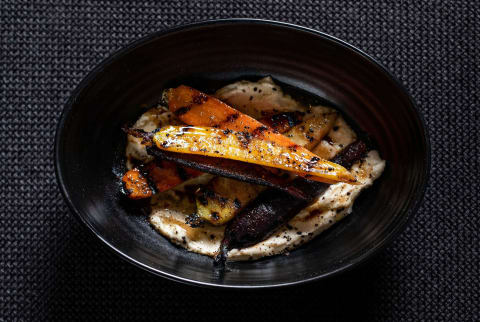
August 11, 2023
Our editors have independently chosen the products listed on this page. If you purchase something mentioned in this article, we may
Meat tends to take center stage at barbecues, but vegetables shine on the grill too. High-heat caramelizes their natural sugars, lending them a slight char that deepens their flavor. Onions become sweet and tender over a flame, while corn takes on a smoky edge.
If your experience grilling veggies starts and ends with pepper and onion skewers, fear not. We consulted Morgan Jarrett, the executive chef at STATE Grill and Bar, who specializes in vegetable-forward cooking, about how to grill your greens (and reds and yellows and purples). Here are her top tips:
Advertisement
This ad is displayed using third party content and we do not control its accessibility features.
1.
Go for lesser-known veggies
Many people reserve grilling rights for classics like peppers and onions, but broccolini, trumpet mushrooms, and kohlrabi all shine. Corn is also at its best when slightly charred.
Sturdy summer stone peaches and plums can stand up to the heat, which caramelizes their natural sugars and intensifies their flavor. Toss stone fruits with a pinch of sugar and blister them on the grill to complement a savory salad, or serve as a base for a dessert.
Advertisement
This ad is displayed using third party content and we do not control its accessibility features.
If you remove veggies from the grill only when they’re cooked to your liking, you may find them overcooked by the time they reach your plate. That’s because of a phenomenon called “carry-over cooking,” in which an item that is hotter on the outside than the inside will release some of its heat internally, heating the inside and furthering the cooking.
To use this to your advantage, remove veggies from the grill just before they finish.
Avoid stacking vegetables after cooking so they don’t continue to steam each other.
Learn how to fill your health gaps in 90 seconds.

Cook harder, denser vegetables, like beets, on a higher shelf of the grill for a longer amount of time. Save the main space for softer veggies like zucchini.
6.
Don’t forget to marinate
For an all-purpose, universal vegetable marinade, mix high-quality balsamic vinegar, olive oil, and chili flakes. Jarrett adds that you can swap in any acid, fat, or heat source and experiment with Calabrian or Urfa biber chilies as well as sherry or chardonnay vinegar. To sweeten, swirl in honey or pomegranate molasses.
Here’s a favorite riff on this base marinade that Chef Jarett loves to use:
Advertisement
This ad is displayed using third party content and we do not control its accessibility features.
Za’atar Blend Marinade
Ingredients
- 1 T za’atar
- 1 T berbere
- 1 T ras el hanout (a Moroccan spice blend)
- Juice of 1 lemon
- 2 to 3 garlic cloves, microplaned
- ⅓ cup olive oil
Advertisement
This ad is displayed using third party content and we do not control its accessibility features.
Directions
Whisk together all ingredients. Use it as a marinade for your vegetables before grilling. You can adjust the amounts according to your taste. The marinade will keep in the fridge for several days.
The takeaway
These chef-approved tips will keep your summer veggies from going soggy or losing flavor on the grill. The final product will shine in a refreshing appetizer, satisfying dessert, and everything in between.
Advertisement
This ad is displayed using third party content and we do not control its accessibility features.

